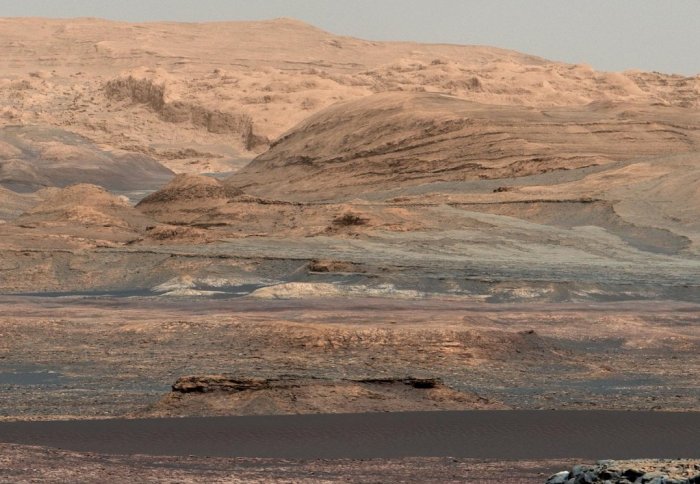
These sand dune formations in the distance are unique to Mars

NASA discovers more about Mars' ancient atmosphere by studying a dune system, which is named in honour of an Imperial Fellow.
The Mars Science Laboratory (MSL) mission is a long-term effort by NASA to robotically explore Mars. As part of the mission a car–sized roving laboratory called Curiosity is travelling across Mars’ Gale Crater and steadily climbing up the side of Mount Sharp, located at its centre. Curiosity is helping scientists to assess whether Mars ever had an environment that could support simple life.

Part of the Bagnold Dune imaged by Curiosity
The rover is currently carrying out the first ever investigation of desert dunes on another planet. The NASA team have named them the Bagnold Dunes in honour of Brigadier Ralph Alger Bagnold FRS OBE (1896 -1990). Studying the Bagnold Dunes and ancient rock formations has suggested to the team that by 3.7 billion years ago Mars’ atmosphere was already thin.
Bagnold was the founder and first commander of the British Amy’s Long Range Desert Group, which was a reconnaissance and raiding unit based in North Africa during World War II. He is generally considered to have been a pioneer of desert exploration. He wrote the first book on the movements of sand by wind, called The Physics of Blown Sand and Desert Dunes. Watch an old interview with Bagnold in the video Blown Sand.

Bagnold (pictured) also made the first recorded east to west crossing of the Libyan Desert
In the 1930s and 1940s, Bagnold was a visiting researcher at Imperial College London, building its first wind tunnel, and writing a book on the subject.
Professor Sanjeev Gupta, a fan of Bagnold’s early work, is part of the NASA Curiosity team from Imperial’s Department of Earth Science and Engineering.
Professor Gupta said: “I am thrilled that we have been able to name the first ever extra-terrestrial dune system explored on the ground after an Imperial luminary. Ralph Bagnold was one of the first researchers to really understand the physics of dune systems. While he was never one to seek acclaim for his efforts, I know he’d be so excited to see how his work is being applied to understanding dune systems on another planet.”
Wind-blown dune systems are abundant on Mars, but have never previously been investigated on the ground. The study, published today in the journal Science, involved looking at how wind on Mars blows and moves sand in desert dunes. The investigation also included looking at how the sand is deposited and the chemistry of the sand grains.

Professor Gupta is a fan of Bagnold's early work on sand dunes
The team have discovered a new class of sand dune formed by wind called wind-drag ripples. These are not observed on Earth. The researchers suggest that these ripples are formed as a consequence of the low density of the Martian atmosphere.
The NASA researchers have also observed wind-drag ripple features that have been preserved in ancient sedimentary rocks in Gale Crater, which were formed via the same wind-blown effect. By comparing and contrasting the ancient sedimentary rocks with the dunes it is helping the team to build up a picture about Mars’ already thin atmosphere.
The next steps will see the Curiosity rover climbing even further up the slopes of Mount Sharp. The NASA team will analyse ancient lake deposits in the form of a basal rocks, which now make up parts of Mount Sharp. The team will analyse the chemistry of these rocks, which in turn will provide insights into the chemistry of the ancient lake deposits. This could enable the team to learn more about the chemistry of Gale Crater’s ancient lakes and what environmental conditions on the planet were like.
*Martian images courtesy of NASA
*Bagnold image courtesy of Professor Colin Thorne, School of Geography, Nottingham University.
‘Large wind ripples on Mrs: A record of atmospheric evolution’ by M. G. A. Lapotre, R. C. Ewing, M. P. Lamb, W. W. Fischer, J. P. Grotzinger,D. M. Rubin, K. W. Lewis, M. Ballard, M. Day,5 S. Gupta, S. G. Banham, N. T. Bridges, D. J. Des Marais, A. A. Fraeman, J. A. Grant, K. E. Herkenhoff, D. W. Ming, M. A. Mischna, M. S. Rice, D. A. Sumner, A. R. Vasavada, R. A. Yingst in Science.
Article text (excluding photos or graphics) available under an Attribution-NonCommercial-ShareAlike Creative Commons license.
Photos and graphics subject to third party copyright used with permission or © Imperial College London.
Reporter
Colin Smith
Communications and Public Affairs

Contact details
Email: press.office@imperial.ac.uk
Show all stories by this author




Leave a comment
Your comment may be published, displaying your name as you provide it, unless you request otherwise. Your contact details will never be published.